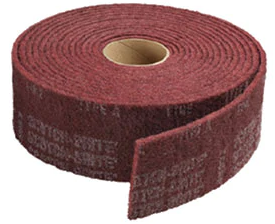Dulux metalshield
When sanding:
– Scotch brite
– cordless drill with 150mm round velcro sanding pad
– multitool with standard scraper blade and triangular sanding pad.
– orbital sander
When painting, keep this handy:
– Rags
– Tissue paper
– 1x nitrile or latex glove on hand you are painting with
– Mineral Turps
– keep all paint on sheet of cardboard ‘workstation’ to reduce spills.
– Paint stirrer cordless drill
– Hammer
– Large screwdriver
– Flat piece of timber to close lid on paint tin
For latex paint, wrap a plastic bag around a paint tray.
Enamel paint of any brand does not stick well to galvanised metal (duragal RHS). Flakes of paint chip off on small impact.
Multitool with standard toothed blade to scrape off rust in difficult to access areas. removes primer exposing mill scale, bare metal and rust.
Multitool with sander attachment for all localized areas, or cordless drill with 150mm velcro sanding disc and orbital grinder disc pads.
Orbital grinder for large sections, or roughen with Scotch Brite hand sanding pad if only recoating existing paint.
Bondall 250ml Ranex Rustbuster Rust Converter (plastic cup and sample pot brush).
– Do not let acid drip onto house wall paint as this leaves marks.
– Phosphoric Acid converts exposed rust to a phosphate of iron (black in color) in minutes.
Clean surface with just water to neutralize acid.
Dry surface with cloth or paper towel.
Clean surface with mineral turpentine ready for paint.
Dry surface with cloth or paper towel.
Masking tape to prepare the area.
Paint rust converted ares with gray zinc primer spray paint.
Get a decent quality paintbrush.
Soak bristles in mineral turpentine.
Paint stirrer tin of paint.
For small brush / half empty tin of paint, use tin.
For large brush / full tin of paint, use a plastic container.
A square/rectangular plastic container makes it easier to wipe brush than a round container.
If your paint is too thick it will cause drips, no matter how perfect your paint strokes are.
[!] Drips are never the result of paint being too runny / too thin; drips are the result of paint being too thick!
Pour a teas spoon / table spoon of mineral turps in enamel paint in plastic container. This helps thin the paint so it flows smoother and reduces drips.
Paint gray zinc primer paint areas first. Thin coats, don’t try to mask gray by slathering on a thick coat of paint. Paint will cover better as it dries.
Now paint overall area to be painted, going over pre-painted areas last.
When painting upside down, scrape bristles of brush on edge of container starting from the handle towards the tip, to remove paint build-up hiding inside bristles near the handle. – pull brush along edge of container to scrape off excess paint.
You can keep a paintbrush overnight by wrapping the paintbrush in tinfoil with a splash of mineral turps. Paint on a bit of old newspaper to get rid of old paint in the brush. Do the same to get rid of mineral turps when you start painting (or just thoroughly stir paint in container and turpentine in the brush before you start painting).
There is no point trying to re-use paintbrushes. False economy. The flimsy metal around the handle holding the bristles always starts to rust soon after use.
